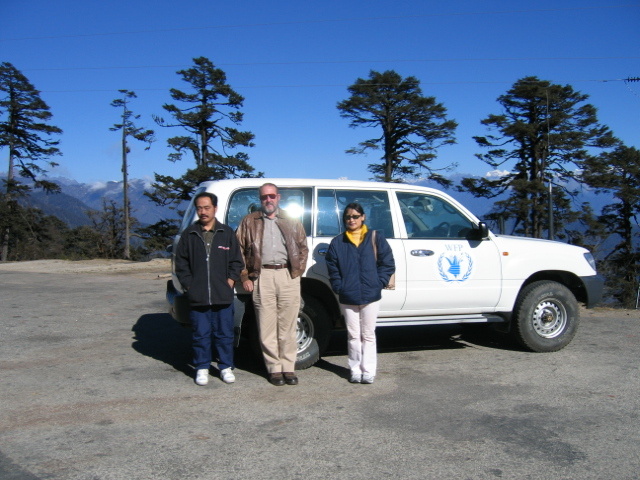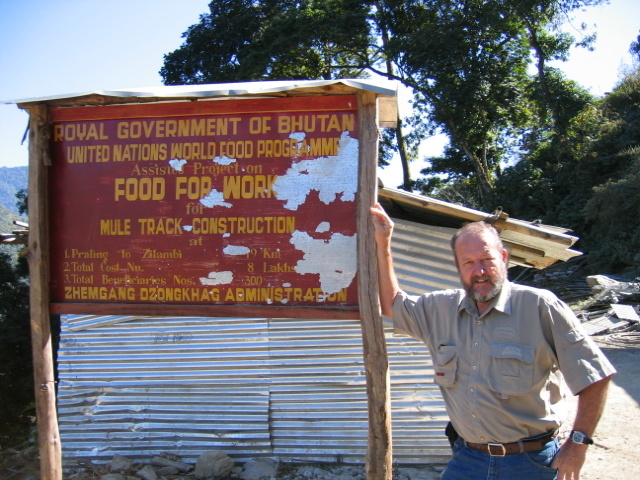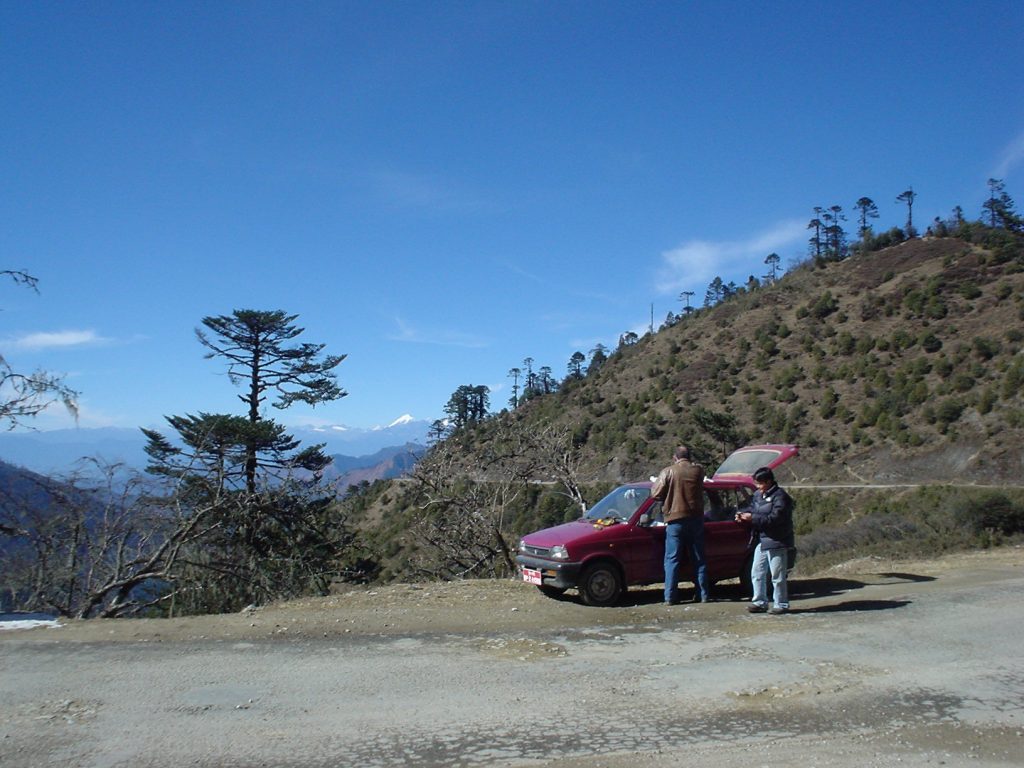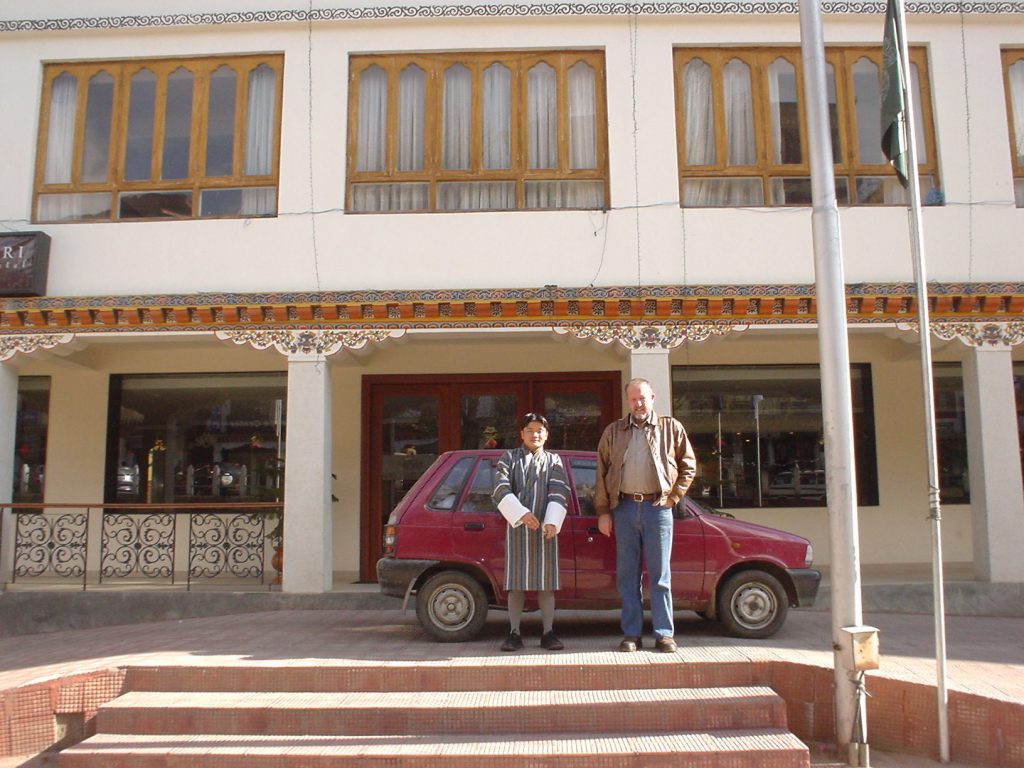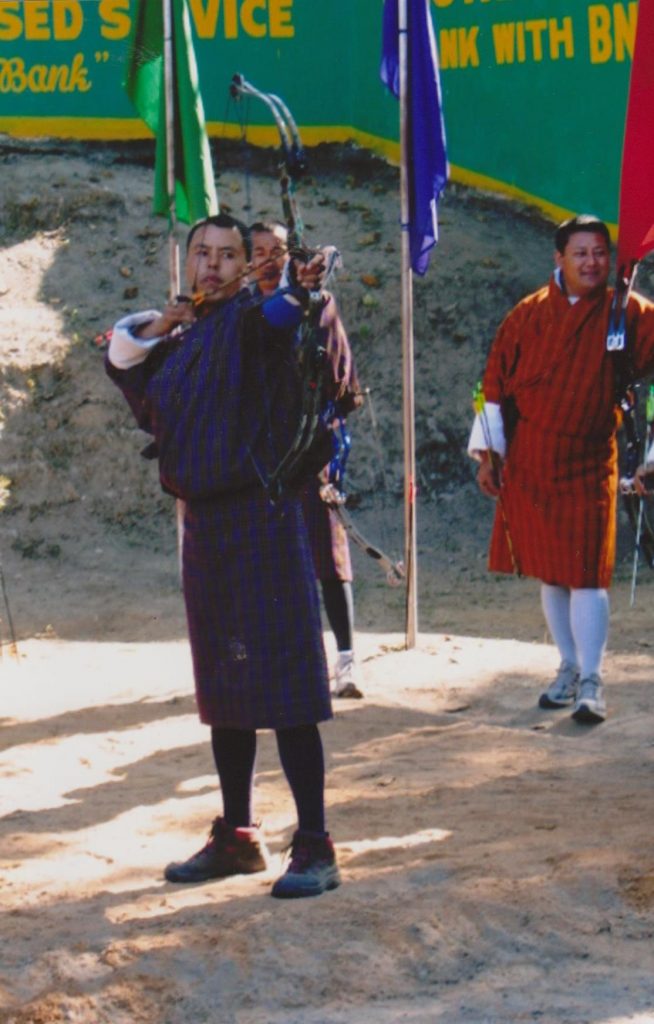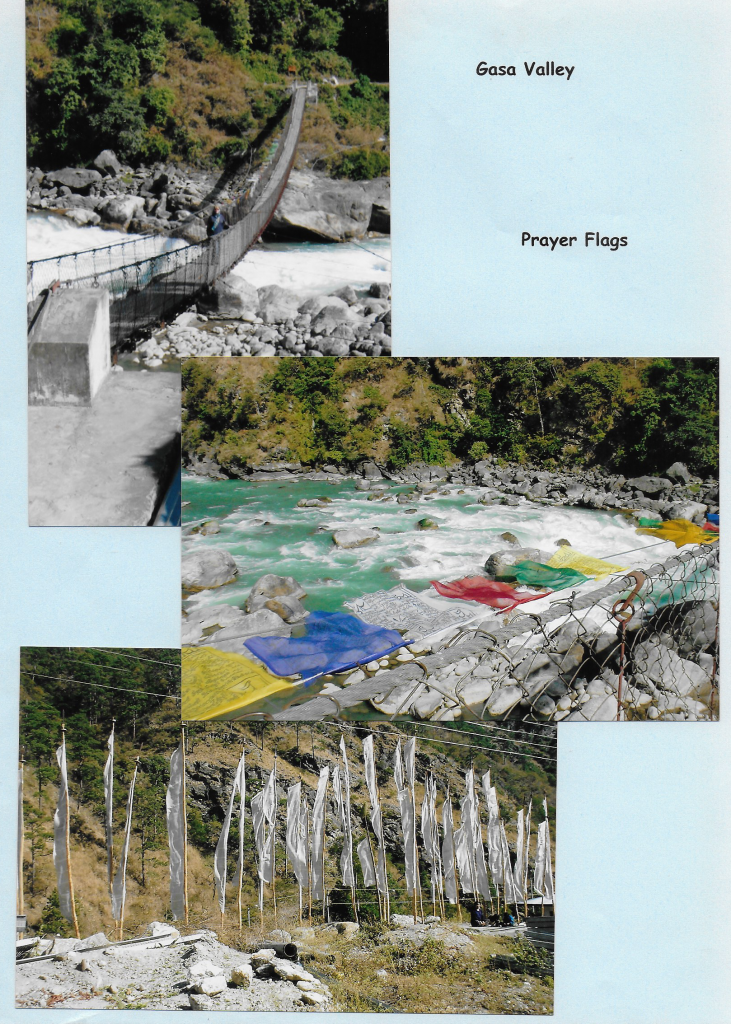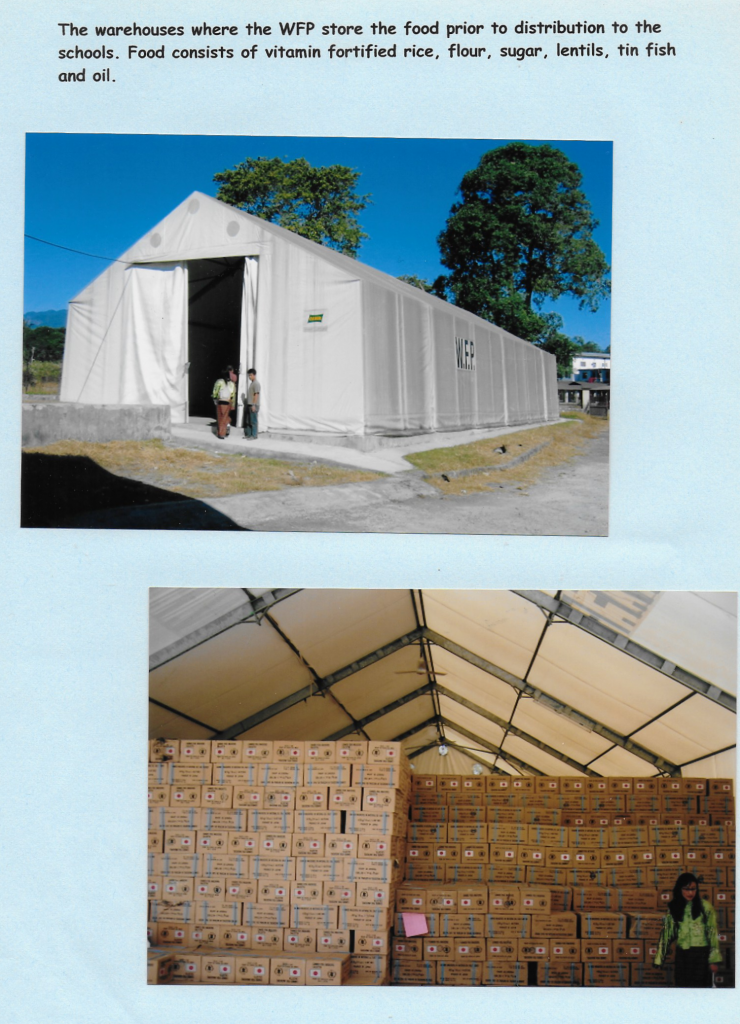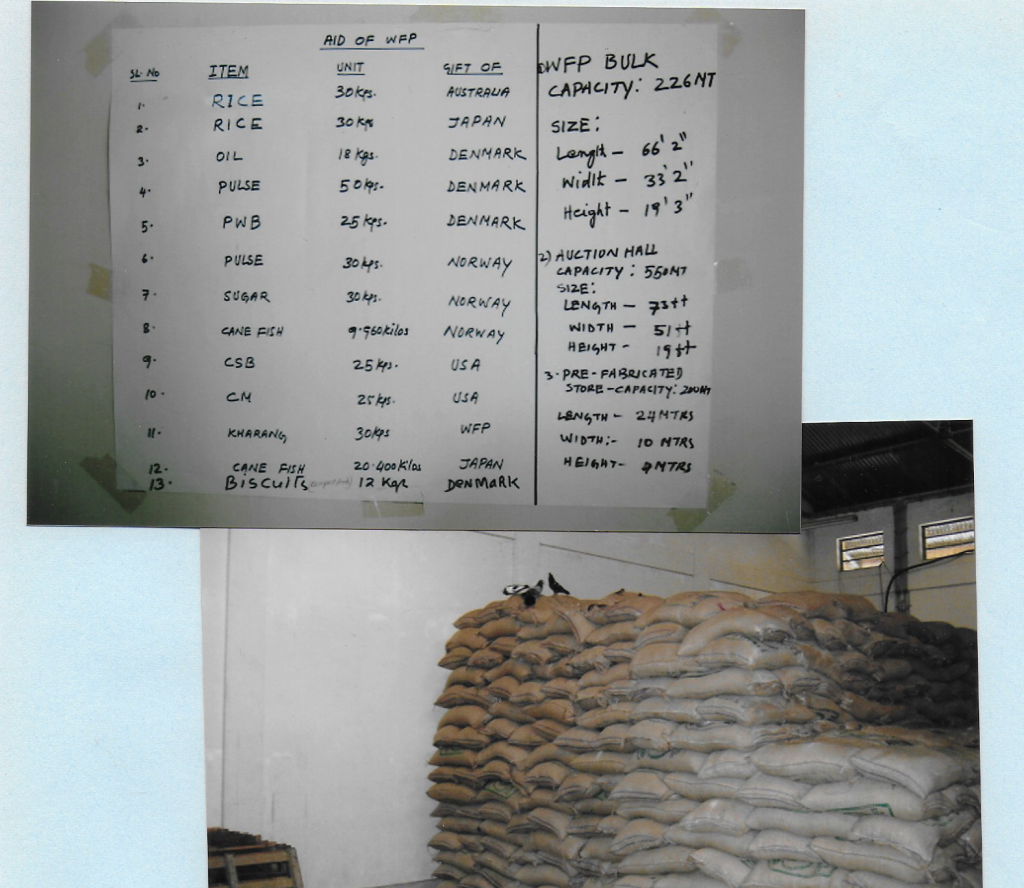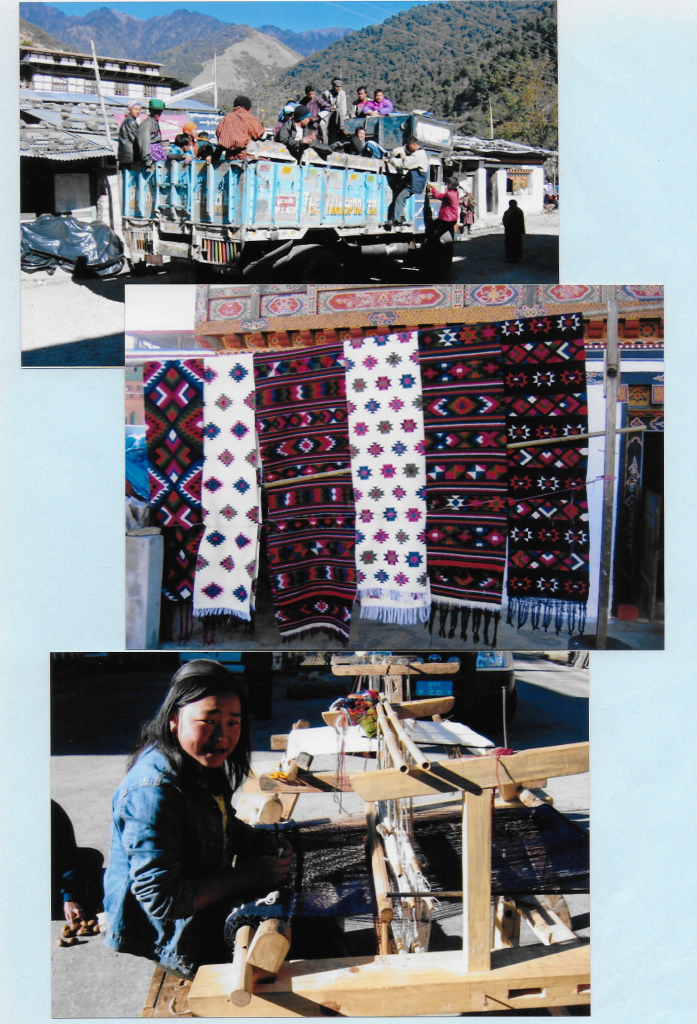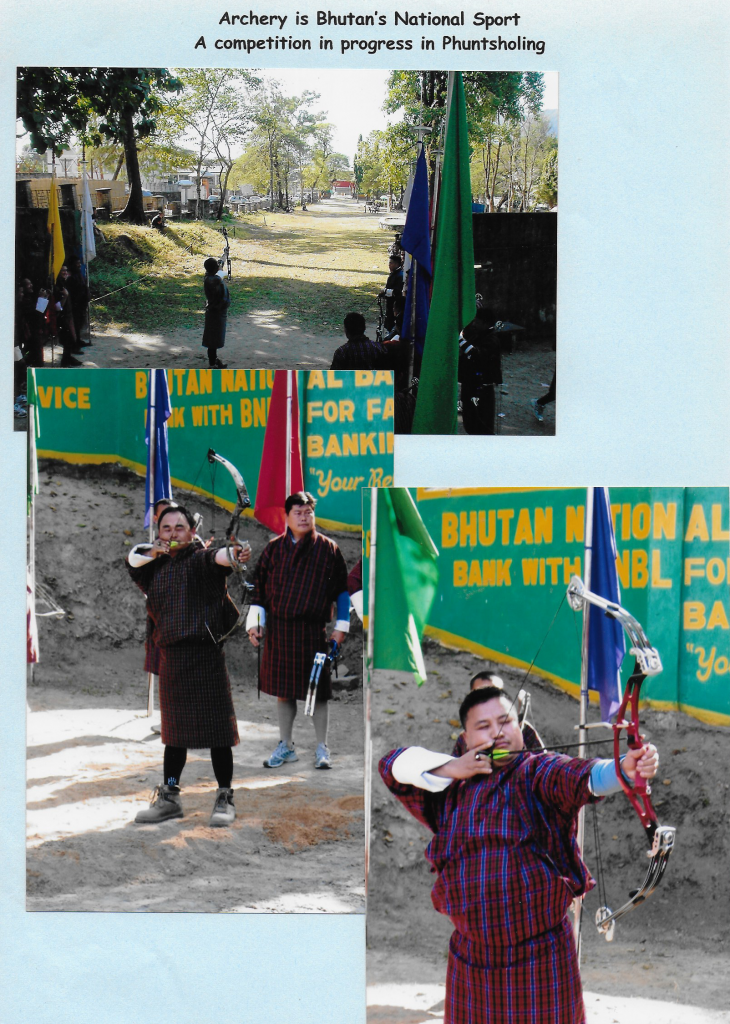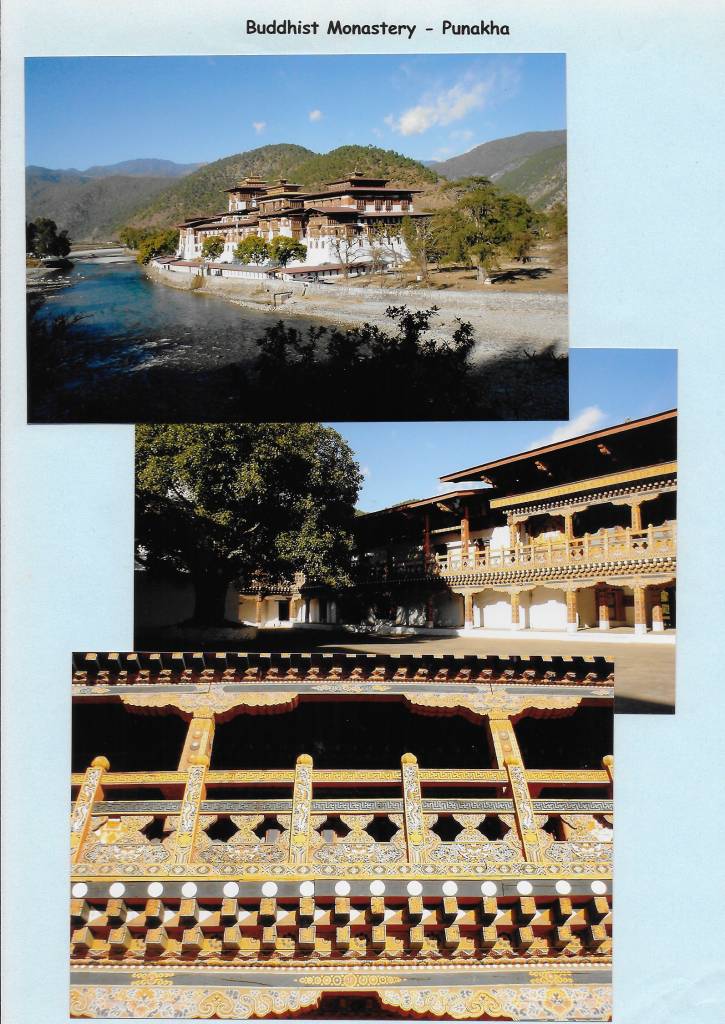An explanation of the WFP (United Nations World Food Program)- School Feeding
Followed by six reports from Lang during his time spent in Bhutan
. Significantly increases enrolment and attendance
. Enhances a child’s ability to concentrate and to learn
. Ensures a child at least one nutritious meal a day
. Creates the opportunity for girls to attend school rather than work
The World Food Programme is committed to working with the Royal Government of Bhutan toward the goal of universal basic education for all by 2007. Since 1974, when WFP began working in Bhutan, to 2000, literacy rates have risen from 17.5% to 54%
WFP assistance enables the government to provide two meals a day to boarding school students and a mid-day meal to day school students. Primary school students get an additional mid-morning snack made from corn-soya blend. WFP feeds about one-third of all schoolchildren in Bhutan.
Each meal contains rice, sugar, lentils, canned fish, oil and maize meal, all supplied by WFP. Fresh vegetables and condiments come from parents or the government. The meal is both nutritionally balanced and substantial, an absolute necessity when children walk a minimum of two hours each way to get to and from school.
WFP needs $3.5 million – in cash or contributions of food commodities – to run the school feeding programme in Bhutan for one year. For an average of US 19 cents a day, a child’s future can be changed. As just one example, UN studies show that educated women marry later in life and have fewer children.
Without WFP, a girl like Tashi could easily end up as a labourer in the house and the fields for the rest of her life. But school gives her parents as attractive alternative.
At school she gets the most substantial meal of the day. And education holds out the promise that she will one day earn a salary she can share with her family.
School feeding. It really works
BHUTAN BUGLE 1 2005/2006
Well, the UN finally got itself organised and after changing arrangements to go to Nepal, Bhutan, Pakistan and finally back to Bhutan in the space of 10 days I arrived in Katmandu (the area headquarters) for a briefing on my task. I have been appointed standby logistics officer to be based in Phuentsholing on the Southern Bhutan border with India.
It remains to be seen what work entails but it is initially based around improving the regular supply of food to schools in this very remote country. Some of the schools are 6 days’ walk each way from the end of the road. I hope to be able to follow a sack of flour (donated by USA, Australia, Germany and others) from its arrival in Calcutta then by road to Phuentsholing warehouses (my base). Distribution then goes by smaller truck to the end of the road and is transferred to donkeys, mules or yaks. Some tracks are so bad it is loaded on the backs of porters for transport right up to the Tibetan border. I will be shadow of my former self after all the walking!
The 10 days in Katmandu involved sitting in on a course training people to micro-manage the WFP (World Food Program – UN’s largest agency) food supply chain. There are 104 forms – yes 104, in the system. The only thing that saved me slashing my wrists was the fact I regularly fell asleep.
Anyhow I managed an outing with the local Hash House Harriers up on the mountainside although I must admit I went in the women and whimps group – don’t need a heart attack at this stage!
The flight on Bhutan’s national carrier Drukair was well worth the trip so far. Lifting off from the Katmandu Airport we were soon out of the smog into a cloudless blue sky and turned east towards Paro Airport in Bhutan. In the crystal clear sunshine we climbed to 29,000’ and ran along the Himalayas. Shortly after take-off I looked out the window (after the Captain commented) and there, not 5 miles away, at exactly our height, was Mount Everest.
The A319 Airbus (the baby of the fleet) commenced its descent and dived into a narrow valley the like of which I have not seen since New Guinea days. The country’s only airport is strictly visual flight rules (no night or bad weather approaches). We descended down the ever narrower valley following its twists and turns like a fighter, with trees just off the wingtip and the captain talking regularly assuring everyone this was normal. If all airline flying was like this I would have joined an airline after leaving the army!
The final manoeuvre was at 200’ above the ground and the wings rolled level just as we crossed the runway threshold. The strip is built in the river bed and a cliff runs along the full length of the runway less than 100 metres from the centre-line. The rescue services turn out for every landing (one a day). The ambulance waiting to provide assistance for 200 passengers was a small Suzuki four wheel drive. The fire truck would have been like a little boy pissing on the Great Fire of London. As I said to Mark, it’s the thought that counts.
BHUTAN BUGLE 2
Having arrived at Paro Airport we had to drive the 60km to the capital Thimpu which is in the next valley. It took over two hours on the narrow winding road. I doubt there is any flat ground in Bhutan.
The rushing rivers are unbelievably clear as they come from the snowy peaks to the north. In the sections between the rapids the water is totally transparent. A great pity this pristine water eventually finishes up in the Brahmaputra (Brahmaputrid?) River in India. The buildings are very un-Asian and the towns look like Swiss villages.
Everyone wears national dress (compulsory for government employees) and the society is based around the Bhuddist religion and the King. The King is a benevolent despot despite the illusion of a parliament, which he can, and does over ride. The Monks have 20% of the seats in parliament. Despite all this, the first impression is of a pretty contented people, happy with the, undoubtedly popular, king’s superior wisdom.
The local newspaper is a totally sycophantic publication but there are no restrictions on 50-channel cable/sat TV or broadband Internet services. Mobile phones work in two or three of the bigger towns (with a population of 600,000 in the whole country, “big” is a relative term). English is universal as it the language used in the schools.
Tourism is totally controlled with only 7,000 per year (140 per week!) coming in to the country. $US200 per day must be spent and everyone must be accompanied by a tour leader. If you come as a couple or singly you still must have a tour guide and get charged 40% extra!
The king does his duty and, coming back from the market in Thimpu, I saw a kid’s school athletics carnival on the city sports field. Right on the finish line there was a large white tent with the king in all his golden finery sitting on a large throne-like chair surrounded by his 4 Queens (like being on a QANTAS flight), courtiers and advisers. Reminded me of King John at the jousting competitions.
After a couple of days in the capital Thimpu I set off to drive the 170km to Phuentsholing on the Indian border. We only stopped for a twenty-minute break for lunch and the trip took 6 hours. I doubt there was 100 metres of straight road anywhere on the journey. A single lane continuous switchback road precariously cut into the valley sides is the main highway in the country. Landslide closures are a daily occurrence. It is not without just cause that the Thimpu-Phuentsholing bus is called the “Vomit Comet”. The traffic is not heavy but when you come up behind a truck it stops immediately on the toot of the horn to let you pass. I have never seen such polite drivers.
Arrival at Phuentsholing is quite spectacular, as you are still 2,500 feet above the town 5km out. The mountains just form a wall rising up from the Bengal plains – no foothills. As we got further south the sparse vegetation turned into full-on rain forest.
When the British forced the Bhutanese to give up their territory in the 1800’s they drew the border right along the hills leaving the Bhutanese not one square inch of their previous fertile Brahmaputra Valley plains. The Indian border runs right through Phuentsholing and is basically open. The border actually divides a street with just a deep stormwater drain indicating its presence. People are supposed to go through the gate but the police occasionally remove planks across the drain placed by those too lazy to walk up to the official crossing. All Indians must be back in India by 6.00pm.
How they would ever know has got me beat.
I did an exploration into Indian Jaigiang, the sister town or, more correctly, the southern half of the Phuentsholing/Jaigiang city complex. I was a little worried about getting back as I did not have my passport so I asked the customs inspector sitting on a deck chair on the footpath as streams of Indians flooded by into Bhutan for the day.
“Do you have a Bhutan visa?”
“Yes, but I do not have my passport with me.”
“That is OK. Just so long as you tell us you have one you can come back in.”
So much for the three weeks notice for visa application, issue of individual invitations and prepayment of $200 per day!
The comparison between Phuentsholing and Jiagiang is quite remarkable. The Bhutan side is quiet, orderly and clean while on the other side of the gate it was a typical seething Indian town with broken drains, piles of rubbish, beggars and shouting shopkeepers.
My duties commenced with inspection of the various warehouses holding hundreds of tons of food for the school distribution in January and resulted in a big list of repairs and modifications for the Food Corporation of Bhutan to carry out.
The worries about the Bhuddist aversion to killing (rats) have been overcome by employing Indian warehouse labourers The killing aversion is not a universal embargo or moral position but a personal restriction on the path to enlightenment. If others choose to kill that is their bad luck and they will never reach Nirvana.
I could not understand seeing Bhuddist monks wolfing down Lamb Roghan Josh or beef kebabs until it was explained that Bhudda said you must not kill but never said you can not eat meat. An underclass carries on the trade of butchers accepting they are never going to reach enlightenment while providing the pious with food. “If it is already dead, we may as well eat it.”
Sex Crazed Grandmothers:
Read the article in today’s paper describing how 50% of condoms issued in the AIDS prevention program have gone to women aged 60 to 80. No such luck for the grandfathers as investigations revealed the lubricant on the condoms enhanced the smoothness and appearance of the fine threads the grandmothers use in their traditional weaving!
Lang
BHUTAN BUGLE 3
Having been in Bhutan for 3 weeks WFP decided to send me on a ten day tour of the country to inspect all the small food stores in preparation for the next food distribution in January. I traveled the 168 kilometres (and six hours driving) from my base at Phuentsholing to the national capitol of Thimpu. After a night in the hotel with earplugs worn against the hundreds of continuously barking dogs, I set off with Megrehj, the Food Corporation of Bhutan representative, Tashi Doma the WFP Logistics Officer and Tashi our driver (Tashi and Tashi are male and female but the name is bisexual so to speak).
We headed into the mountains on the usual single lane ledge hacked into the cliffs. The scenery is spectacular and at one stage we crossed a 12,500’ pass, sliding on black ice inches away from an unguarded 1,500 foot vertical drop. Each morning when we set off Tashi spent about 5 minutes singing under his breath. When I asked him what he was singing he told me he was praying that we would not slide off the mountain today. I thought this was a pretty good idea so told him before he finishes his conversation with Buddha each morning to say “Lang sends his regards and says the same.”
One night we stopped in Mongar (9,000’ altitude) and checked into a basic establishment (with resident dogs of course). There were cracks in the walls and I had to get into my sleeping bag under the bed covers. Arising next morning I went into the “bathroom” and went flat on my back. There was no shower and you had to bucket water over yourself and the water left on the floor from the night before had frozen into a sheet of ice.
Over the next few days we went from small store to small store. Most of these are built on ledges in or near a tiny settlement and are as far as trucks can travel up that particular valley. The schools then come down with their horses, donkeys and yaks to collect the food and take it back into the mountains. A couple of schools in this area are two days walk but in the north east there is one requiring six days walking.
During inspection of one store a truck, loaded with rice, arrived from India. As it backed up to the loading ramp I noticed a family of rats leap off the back and scurry straight into the store disappearing under the pallets of bagged food inside. The boys told me these were not just any rats – they were Bengal Rats! I got a pretty good look at them and think the only way to tell the difference between the touring Indian rats and the Bhutanese stay-at-home variety is by their suitcases, sunglasses and Hawaiian shirts.
We finished one day at a small village near the Tibetan border which just happened to be our driver, Tashi’s, home town. He told us that after we were settled at our hotel – for want of a better word – his parents wished us to come for dinner.
He later picked us up in the Landcruiser and we scrambled up a four wheel drive track far into the mountains. Eventually we stopped and Tashi pointed to a tiny house somehow attached to the side of the mountain far below the road. The almost vertical twenty minute descent on a rough footpad brought us to his home where his parents scrape an existence from one tiny rice paddy terrace, one cow and a couple of pigs. His toothless old dad and wrinkled, round-faced mother welcomed us into their three room dwelling.
We were taken into the living room where a great effort had been made to prepare with nice carpets, obviously only used for special occasions, laid out for us to sit upon. A rough wooden altar festooned with pictures of the King and the Dalai Lama, cut from magazines and lit with candles stood against one wall.
The first treat was a serving of Arak, the local farm-distilled drink. I had been told previously that this was normally 110 proof (55% alcohol). It is a clear liquid tasting something like a mix of bad sake and rough gin with a dash of paint thinner. Tashi’s dad brought in a saucepan full, heated to just below boiling, which he placed in front of us. He then produced an egg and whipped it into the liquor which was soon swirling with lumps of poached egg. The final touch was a heaped tablespoon of yellow-green rancid butter. This spread across the mixture like an evil scum.
As a very large bowl of arak containing at least half a litre was placed before me I thought “This is going to be interesting.”
Mother saved the day for, before I could put off drinking no longer, she appeared with two large bowls and placed them before us. To each of us she gave a large plate containing rice and, on top, a great pile of the hottest chilies known to man. No other meat or vegetables, just chilies. Of course there were no utensils and we ate with our fingers.
Anticipating a bit of a test, I thrust the first handful into my mouth. I can tell you right now that women in childbirth know nothing about pain! Instantly my eyes watered but I thought it can’t get any worse, so plunged on to finish it in one painful short period. This was a bad mistake.
The pain went straight to eleven out of ten. By now I could not see through the tears, sweat had broken out on my brow and my nose started to run. Not having the forethought to bring a handkerchief, I wiped the flowing snot from my nose with the back of my hand, immediately transferring chili to my nasal passages. About this time I reminded myself of my oft quoted phrase “Giving up anywhere short of death is a mental decision.”
I could not give up in the face of the intense scrutiny of the family but I definitely needed some relief. The only liquid available was the foul potion sitting in the bowl in front of me but, desperate times require desperate measures.
I grabbed the bowl and in one continuous draft consumed the entire half litre. It could have been the finest champagne or diesel fuel as far as my decimated taste buds could tell but at least it was liquid. The pain immediately decreased to a manageable five out of ten.
There I sat with a sweat beaded brow and tears flowing from my eyes down my cheeks. Snot was pouring from my nose over my yellow, rancid butter soaked moustache and lumps of semi-poached egg hung from my beard. But, as I tried to focus through blurred vision, I saw the wide toothless grin and the extra hundred wrinkles that had appeared on the round, beaming face. All in all, I think I carried it off rather well.
The exit on hands and knees up the vertical path in the pitch black darkness remains a little unclear. The next morning I resolved to erase the whole incident from my mind but was unfortunately forcibly reminded by nature a couple of times during the day.
The instant height of the Bhutanese mountains is amazing. After sliding across the high road on slick ice at 3.00pm we were back down on the border of Assam at 5.00pm checking into a hotel fitted with much needed mosquito nets and fans. Samdrup Jonkhar is another teeming border town similar to Phuentsoling with Indians allowed across on a daylight basis. Unfortunately it is the centre of Assamese independence rebels and the Bhutanese close the border regularly any time they get uppity.
I was absolutely overjoyed while wandering around Samdrup Jonkhar to make reaquaintance with a company I had seen in Calcutta 12 years ago. They have obviously been successful and opened a local branch.
J.B. GUPTA & SONS of Calcutta
Purveyors of Lingerie for Ladies of Distinction
We have had a hand in womens’ underwear for 30 years!
BHUTAN BUGLE 4
Having finished a 10 day trip through Bhutan looking at warehouses and school stores prior to the January food distribution it was time to turn around and return to Phuentsholing. The journey from Samdrup Jonkhar in the east to Phuentsholing in the west was only about 200km in a straight line but traveling via Bhutan takes three full days driving via the mountains.
The possibility of going through the flatlands of India existed but created all sorts of security problems. As I think I already related, a couple of years ago the Bhutanese, under pressure from India, cleaned out the Assam Free State rebels hiding in the jungle on their side of the border. The rebels did not take too kindly to this so took out a Bhutanese bus traveling in India and killed 26 people.
Since that time all Bhutanese vehicles must travel in convoy with military escorts until they are out of Assam. There are only three convoys a week and if you miss these the only option is the mountain road and three days driving. Another problem for me was, while the Bhutanese need no permits, all other foreigners in the rebel territory need special approval from the Indian Government. This was easily fixed by a visit to the Indian customs post and an appropriate donation to get a permit stamp in my passport.
Starting early from Samdrup Jonkhar we lined up with about 200 Bhutanese registered vehicles in a tea plantation just over the Indian side. The usual parade of Indian soldiers moved up and down the convoy with clipboards taking down every conceivable detail of the cars and occupants. I am sure I answered the same questions on the same form for three different people. Alongside the soldiers was a cast of thousands of Indian village entrepreneurs selling boiled eggs, masala tea, curry and rice and of course the Bhutanese favourite, betel nut. While the huge convoy was lined up on the narrow single lane road, Indian cars and busses (not subject to restrictions) roared down the wrong side of the road, horns blaring, missing cars, people, cows and goats by inches.
At last we started to move. The convoy on the move covered about 5 kilometres of road. There was a truck full of soldiers at the front and another at the back. About every 5km there were two or three soldiers at the edge of the road. The rebels could have stopped a bus, shot everyone on board and been off into the bush before the rear troops arrived. The front troops would have read about it in the paper the next morning.
Anyhow after about an hour of what appeared to be a full-on rally with everyone tooting and passing we just sort of drifted into a drive through the countryside at our own pace. I never did see the front troops and there was no hand-off or identifiable release point. We stopped for a cup of tea still well inside Assam and in the half hour that we were there the racing Bhutanese cars finally petered out and the road went back to its sleepy Indian village existence. Never saw the rear troops either.
It took 5 hours to reach Phuentsholing driving down the Brahmaputra River valley compared with 3 days via the hills!
My main motivation for pushing the Nervous Nellys at the UN country office for permission for the Indian route (I suspect they only approved because they thought I could not get an Indian permit) was to get back before Bev arrived from Australia. She was only going to be in Bhutan for 10 days and I did not want her hanging around the hotel in Phuentsholing while I was stuffing around in the mountains driving back.
The week before this big trip I endeared myself to the management with my unbounded thirst for work and set up another field trip leaving Phuentsholing on Xmas day to stock take all the small school stores in the beautiful tourist valleys of Wangdi, Punarkha and Pobjika. There was the usual hand wringing by the UN over my desire to drive my own car and I had to sign all sorts of statements saying I would not sue them if I got airborne off an icy cliff along the way.
The permanently employed UN, is composed mainly of people of academic background – predominantly women – with no practical skills that I have been able to identify in two jobs working for them. They have an illusion that it is much safer having local drivers “who know the conditions”. Having driven with these locally recruited, first generation, drivers in numerous countries, giving them a shiny new Landcruiser says much more about the UN’s knowledge of driving than the people behind the wheel.
Anyhow I hired a motorized roller skate in Phuentsholing which the UN agreed to fund at the standard mileage rate. It was a Maruti Suzuki, made in India under licence. I went to check the oil and after a short search in the engine bay saw what appeared to be a watch mechanism that proved to be the three cylinder motor. The 800cc’s put out slightly less horsepower than my lawnmower. It was a good thing first gear was very low or we would not have made it over the 12,500 foot high pass during the trip.
On Xmas morning Bev and I set off on the 170km, 6 hour drive, to the capital Thimpu. Next day we collected Tshering Sumdrup, a young fellow who was on holiday from University doing a 3 month “Internship” (work experience) with WFP. I don’t know if they suddenly gained confidence in my driving or thought an intern was expendable but we set off with a big list of schools to check upon. Of course all hotels were prebooked by WFP and, as the mighty midget struggled up the hill with three of us on board every night, it was with great delight we discovered the best tourist hotels in Bhutan awaiting us.
Not to bore people with repetition I will forego the descriptions of the spectacular mountains, cliff-hanging roads, waterfalls and rushing rivers. Bev had a great time clicking away and the various types of monkeys stood in gangs at the edge of the road to be duly photographed. One mob even had to be shifted as they insisted on blocking the path as they licked the salt from the bitumen. It was spread to melt ice on a particularly nasty bit of road.
We had one great night at Pobjikha where a wide marshy valley is winter home to the black-necked cranes from Tibet. The rough track was almost the death of our little car but the new hotel (needing four wheel drive to get up to the front door) was spectacular. Our rooms were huge with a burning fireplace in each. There were only two other guests. Bev was overjoyed when they issued each person a rubber boiling hot water bottle to take to bed with us as we left the dinner table. I haven’t seen one of these since I was 5 years old.
Bev and I walked to the Education Centre to look through telescopes at the flocks of cranes. The university student counting the birds, said about 350 were in the valley. We felt a bit guilty as the hotel dog, a fine friendly fellow, had decided to come on our 2km walk to look at the cranes but, unknowingly, we took him into the territory of the local canine Hell’s Angels. I am sad to say he was thoroughly done over and was last seen disappearing at high speed with the gang after him. He did survive, as I met him again next morning curled up on the mat in front of the hotel door seemingly none the worse for his drubbing or spending the night in -10 degrees temperature.
After a very interesting week during which we went from snowy passes down to full tropical jungle and saw numerous Buddhist temples, interesting villages (and counted hundreds of sacks of food in various school stores) and winding mountain tracks, Bev and I dropped Tshering off in Thimpu and returned to Phuentsholing.
New Years day once more saw us on the road as we headed into India to take Bev the 150km to Siliguri for her flight from Bagdogra airport to Calcutta and home. She was very taken with the 30 seat busses and their 70 passengers hanging off the rear bumper and on the roof racks. After a ride in the Indian version of a Bangkok TUK TUK and another in the pedal rickshaws we had a delightful final evening at the hotel with workmen pounding on our wall until 10.30 at night.
I dropped Bev at the airport then drove back to Bhutan in the mighty midget ready for the last 6 weeks before completion of my sentence.
Lang
BHUTAN BUGLE 5
This Bugle is based on my most interesting trip so far on this job. There are two areas in the east of Bhutan which are so remote that the reasonably large stores and the schools they serve have not been visited by either the Bhutan Food Corporation (BFC) or the UNWFP for over two years. After a bit of pressure I goaded the WFP into trying to get a permit for me to visit and of course the ‘very difficult’ turned out to be very easy.
Learning from my previous mistakes, I organized an Indian registered Jeep and driver and, along with an FCB staff member and a Bhutanese WFP Logistics fellow, set out for our first port of call, Nganglam. The road leading from the main east-west Brahmaputra Valley highway heads due north into the Bhutanese mountains. It was only 50km from the highway to Nganglam but it took us 4 ½ hours. With nothing more than a rocky track winding its way through the jungle we did not get out of second gear for most of the way. About 7km of the track is along a stony riverbed which, when flooded in the wet season, cuts Nganglam off from the world for 6 months of the year. The Indian trucks bringing in the food during the distribution take two days to do the 100km round trip. No Australian truck owner would allow his vehicles on this track.
The highlight of my whole time in Bhutan occurred about an hour into the journey. As we pitched and rocked at walking pace over the rocks we rounded a bend, and there, not 100 metres away was a large Bengal Tiger. He was idley padding down the track as we stopped. The Tiger continued towards us until he was 30 metres away and, without any recognition of our presence, angled off to the left and faded into the jungle. Best animal sighting I have ever had!
At last we climbed into a narrow valley and arrived at the original Shangri-la. This mediaeval village is straight out of “Lost World” (without the singing). The town is jammed between jungle-clad hills but, unlike the Swiss Chalet appearance of much of Bhutan, every building here was unpainted wood. The people wore a different tribal dress and our vehicle was the only one in town. I created quite a spectacle as it was 18 months since a westerner had been in the area.
Winding down the steep slopes surrounding the little town, strings of pack horses and mules could bee seen descending through the jungle. The only flat bit of ground, serving as village green, football field and town meeting place, also was the pasture for the mule trains coming from the mountains. All around the small field the horsemen had set up temporary woven cane huts in which to sleep while the two hundred odd horses, donkeys and mules were unloaded of their big baskets of mandarins and spices to be set free to graze.
I was very glad of my good sleeping bag that night for the icy winds sliding down from the mountains made it mighty cold on the floor of the cane hut in which we were accommodated. The FCB store man, who lives a lonely existence by himself, made a great effort to cook us a nice lentil (almost certainly pilfered WFP lentils) curry with rice. He also produced a bottle of surprisingly good Bhutanese whiskey to warm us by candlelight.
Next morning we went to his very well kept store to check his stocks and see the condition of the building. Having nothing else to do, he had arranged all the bags of food in the most perfectly stacked manner. They had a bird problem which had been cunningly solved by having a sparrow-hawk (found dead and certainly not killed by the Bhutanese) stuffed in a wings outspread flying position suspended by a string in the middle of the warehouse.
They also had a serious rat problem. I counted 6 rat cages around the warehouse (these are wire cages about the size of a shoe-box which catch the rats, without harming them, for subsequent relocation. The store man flatly refused to use poison or conventional traps). When I asked why none of the traps had bait in them there was a ten minute discussion between the assistant store man, who spoke perfect English and the store man who spoke none. Even with not a single word of Bhutanese, I could see there was considerable prevarication and ducking and weaving going on.
I asked the WFP man to intervene and he eventually got to the bottom of the story. As a very devout Buddhist, the store man thought it was unconscionable to trick the rats into the cages. If you deliberately start lying, even to a rat, your whole life becomes a lie and you will never reach enlightenment.
I thought about the problem for a moment and asked the assistant store man to put the following proposition to his boss. What if we had tiny little signs printed – in Bhutanese and Hindi because, being so close to the border, we could not be sure of the rats’ nationality – and fixed on the front of each cage. “DANGER. ENTER AT YOUR OWN RISK” Place the bait in the cages and the rats, in full knowledge of their actions, could make their own decision to enter or not. The store man’s conscience would be clear.
As the assistant store man earnestly tried to explain the cunning plan to his boss, the blank face and glazed eyes told me he was stunned by this stroke of brilliance from an expert brought across the world at great expense to the UN. Then again, perhaps he thought I was a complete cretin. Whatever his thoughts, as the 2ic continued earnestly with hand waving and pointing to the appropriate place for the signs on the traps I was taken with a fit of the giggles which recurred from time to time for the next 2 hours.
Retreating on another 4 ½ hour rock’n roll trip back to the highway we only saw monkeys and a couple of deer. It was now time to go as far from the capital as possible. On our way to Daifam we had to travel east through Assam then swing north into India’s most remote state of Arunachal Pradesh before re-entering Bhutan. The further east we got, the more impoverished became the Indian villages. Many had no shops at all, only local farmers sitting cross-legged in the dirt with a small pile of vegetables or some fish plucked out of rice paddy waterholes. The shanty woven cane housing was abysmal and the stench was a mix of curry and excreta. A cup of tea for the four of us at a roadside “café” cost 20 cents. Curry and rice lunch for four cost 80 cents.
My arrival in Daifam caused more interest as I was the first westerner that the FCB storekeeper’s 12 year old daughter had met.
There was a problem in Daifam as one of the schools had not collected all the food from the last distribution and there were about 3 tons of bags still in the FCB store. The storekeeper’s daughter (who spoke perfect English) went to that school and told us the 350 boarding kids lived on rice gruel two meals a day for the whole past term. I wonder if “Oliver Twist” was on the school curriculum? The Daifam store still contained the tinned fish, flour, sugar, lentils and oil designed by the UN to give the kids a balanced diet.
It seemed the problem was that the porters did not want to go to this school (9 hours walk away) as they could get more money carting for other government departments such as Forestry. The track was too steep for the mule trains which served the other schools in the district. I could not understand the problem as the government rate for this distance for a porter carrying 30kg was 150 rupees ($4) for the two day round trip but they claimed they were only offered 100 rupees. Nothing for it but a personal visit. Steep hills, night on the ground thinking about tigers, great reception by the headmaster who was rewarded with pre-knowledge that the police would be arriving shortly to take him to jail for pocketing 50 rupees per load.
Leaving Daifam and crossing back into India we met a fellow wearing a washed-out, but neatly pressed, khaki uniform in the first impoverished village. He was the local customs man who asked us to go to his office. I actually had noticed this small, overgrown, hut with a couple of attached rooms on the way up. It had a sign “Foreigners Registration Office, All foreigners must stop and report.” I did not bring it to the attention of my Bhutanese companions who would only have insisted on stopping to obey the rules, losing us another hour.
The customs man had me sit down at his desk (the Bhutanese did not have to register) while his wife brought me some tea. He reached up and retrieved from the shelf a large leather-bound ledger issued by the British in 1863. It was falling apart at the seams but was treated with reverence. He opened the huge tome and I saw at the top of a blank page, written in perfect copperplate writing (could it have been with a quill?) “Register of Foreigners for 2002”. He turned the leaf to another blank page perfectly titled “Register of Foreigners 2003”. 2004 – blank, 2005 – blank.
I can see him now, his whole mission in life is to represent the Indian Government keeping track of almost non-existent foreigners in his district. At exactly 9.00am on January the first each year he arrives in the office to inscribe the page for the New Year. Each day for the next 365 days he arrives at the office at exactly 9.00am and sits, pen poised, ready to record any wandering foreigners passing his domain. The rapturous joy on his face and the bursting pride of his wife was something to behold as he took 15 minutes to record, in perfect copper-plate writing – the details from my passport. I swear there were tears in his eyes as he gripped my hand in fond farewell. I had a warm fuzzy feeling for an hour after our departure.
Departing Samdrup Jankhar via India on this trip was much easier than previously as we were in an Indian registered car. We went through the gate and passed the huge lineup of Bhutanese cars waiting for the military escorted convoy start.
After about 4 hours driving we were told there was a “strike” on the 50 kilometre road that leads from the main highway, north to the Bhutanese border at our destination Phuentsholing. Traffic was being stopped for the day until 6.00pm by disgruntled villagers demanding the government honour its 10 year old promise to fix the road. There were three small towns each with roadblocks effectively cutting off traffic between the two countries.
As we approached the first village there was a line-up of about two hundred trucks and cars. I had the driver pass along the line to the front of the queue where we saw a great pile of tables and chairs across the road. There were numerous red, hammer and sickle flags to be seen. The crowd was as one would expect at any political rally or union stop-work meeting in Australia or elsewhere. A few loudmouths strutted out front and the brainless rabble made lots of noise in the rear.
I decided to play the UN card and got a very friendly reception when I explained that the Secretary General was taking an intense interest in their road widening program and in fact was considering the idea of bringing his own wheelbarrow to India and undertaking the task personally. They opened the barriers and let us through.
The reception at the second town was very aggressive as we drove along the line to the front of the queue. The ringleader was denying our passage in a mixture of English and Hindi in a loud voice for the benefit of his disciples. The disciples reminded me of the poem “The Man From Ironbark”;
….and a row of gilded youths, sat along the wall,
Their heads were flat, their eyes were dull,
They had no brains at all.
It was obvious that the previously successful gentle approach would not work here. Loud enough for the disciples to hear I let it be known that one phone call from me and the UN Security Council would cease discussing North Korea, Iraq and the Gaza Strip. Within 48 hours a full division of the UN ready response force, comprising of crack troops from Monaco, Tasmania and the Galapagos Islands would be floating down onto Hasimara to teach them a lesson they would never forget – or words to that effect.
There appeared to be some doubt as to the veracity of my statements . I may be wrong but I think haramkhor means bullshit in Hindi. Faint heart never won fair lady so I moved close to the ringleader and stood arms folded, legs apart, staring him in the eye. He blinked first and they let us through.
The third town was only 7km south of the Bhutan border and the Bhutanese WFP Logistic officer with me, overcoming his stated premonition of being beaten to death and emboldened by our previous success, said he knew some of the rabble in this crowd and would get us through the last hurdle himself. As he diverged from the usual obsequious Bhutanese manner and became authoritative I thought he overplayed his hand somewhat.
In an uncharacteristic loud voice he demanded this important UN Delegation be allowed to pass. If we were detained, the entire Bhutanese Army of 3 would sweep across the border and push the whole Indian population of one billion into the sea. It worked a treat. Not only did they remove the barriers to let us go but they let all the other vehicles pass as well – when they all went home for dinner only 4 ½ hours later!
Lang
BHUTAN BUGLE 6
This will be the last bugle as the much looked-forward-to homecoming is fast approaching.
Today I have been cheering on the FCB (Food Corporation of Bhutan) archery team in the national finals. Archery is the national sport and they are as serious about it as some countries are about soccer.
The archers use either traditional bamboo bows over 100 meters – fairly rarely nowadays – or modern carbon fiber hunting bows over an unbelievable 140 meters. This is more than twice the distance Olympic archers with their rifle sights and balance weights shoot. As well as the distance being huge, the target is less than half the size of an Olympic target.
With 11 in each team, players take it in turn to shoot. Scoring is not direct but on the deducted system; i.e. at the end of each round the total arrows in the target are counted. If team A gets 4 hits and Team B gets 3 hits then Team A scores 1 point for that round. First to 25 in best of 3 matches wins. No wonder it takes a day and a half for a game.
I have mentioned before they take it seriously and two incidents today illustrated that. The first involved the great taboo of a woman ever touching a bow. One of the FCB office girls was setting up the lunch in the shade and moved an archer’s bow off the table. The end of the world had arrived. She retreated in tears back to the office and the archer had to borrow a bow as his female-contaminated one obviously would not be accurate. They even have a rule to refrain from sex the night before a match, which obviously qualifies archery as an extreme sport.
The second incident almost turned into a full-scale riot. The FCB team was sitting around under the trees having a nicely catered lunch and a monk, who was related to one of the players, was in the group for a free feed. The opposition talked themselves into believing that the monk was giving the FCB team divine backing and possibly casting some sort of bad omen on them. Raised voices and some pushing and shoving ensued before wiser heads told the monk to make himself scarce.
The last field trip was taken to Gelephu, a border town about the centre of Bhutan. I was following the trucks right through from the main warehouse into the mountains and then watching the unloading at the drop-off point and the loading onto the horses and mules.
We were caught by a very late start to the snow season and had an interesting drive back through the hills with heavy snow falling.
While I was in Gelephu I visited the distillery where they blend scotch whiskey (imported in concentrated form) with the “pure Himalayan water” to produce a product equal to Chivas Regal or Johnny Walker Black. The distillery is owned by the Army Welfare organization and all profits go to pensions, retirement funds and army family medical treatment.
We climbed about 50km off the main road north along a brand new road to the very remote Bulli school. On the way back down the mountain a landslide created by workers finishing the construction had brought down, along with the rocks, a huge teak tree which lay across the road. Unfortunately the boys had got their only chainsaw jammed in the 4 foot thick log and we were not going anywhere.
The number of experts slowly increased as people arrived on foot or with their pack-horses and soon a crowd of 20 were all heaving at the 20 ton log with little result. It was just like Excalibur. Everyone who came along, no doubt few having ever seen a chainsaw before, walked up and heaved and struggled to pull it out. Alas, King Arthur was not in our midst!
I just sat on the edge of the jungle enjoying the view across the valley while they got themselves sorted out. Conditions were made slightly less pleasant by the Indian road workers (Bhutanese don’t work if they don’t have too).
40 meters away from the noisy log team, the rock removal team was operating. The jammed chainsaw was the total sum of machinery on site – everything else was crow bars, sledge hammers and wooden poles. To reduce the big boulders to a manageable size they were wrapping detonator cord around the rocks and lighting what I considered a fairly relaxed minimum length fuse.
Every ten minutes or so there was an ear-splitting crack and everyone was showered in shrapnel!
Next to arrive on the scene was the Grand Master Monk from the mountain top monastery situated in the mists far above us. He had with him his Chief of Staff, a couple of senior officers and four or five monklets. GMM immediately took command of the operation.
Each family has traditionally given a son to become a monk – either the youngest son or the unemployable family idiot. This is a good deal for father has one less mouth to feed and the other sons have one less share to split the farm when the old man dies. As a result there is no great super reverence for the many rank and file (or for the Americans, enlisted) monks wandering around. Masters and Grand Masters are treated with a Popish reverence.
Chingis Khan (as the Mongolians call him) wrote that all officers have two of the following four qualities – Smart/Dumb and Energetic/Lazy.
Smart/Lazy makes the perfect field commander. He sees the crux of the problem, discards all superfluous operations and decides on maximum result with minimum work.
Smart/Energetic makes the perfect Staff Officer who covers every detail and makes sure the commander has what he wants when he wants it.
Dumb/Lazy are essential to fill those backwater jobs that would drive Smart or Energetic people insane.
Dumb/Energetic – Must be dismissed immediately!
Our GMM was Officer Type Class 4. He had spent so much time contemplating his navel that he would not know if his backside was on fire. I have not seen such a combination of arrogance and incompetence since Gough Whitlam was sacked as Prime Minister of Australia. Every single command he made was exactly not the one which was required. The boys, at first did as he wanted out of respect for his position but soon even the most pious of them realized the man was a fool and it was not long before a game started.
Each time he ordered Left the group pushed Right. Each time he said Pull they Pushed. It was all pretty childish but also pretty funny as the GMM became more and more frustrated. Eventually he spat the dummy and stormed off with his little entourage following (and no doubt snickering) in his wake.
After moving the log a couple of millimeters they managed to widen the cut enough to disassemble the chain saw to get the bar out but leave the chain jammed in the log. One of the pack horsemen unloaded one of his steeds and rode bareback a couple of kilometers to the construction camp to bring back a spare chain. This was fitted and after an hour of sawing, and two more comprehensive jams, we were free.
There was a good ad in today’s paper:
Government Disposal Auction.
The Tibetan Border Force of the Royal Bhutan Army is disposing of the following equipment: 14 used Yaks, Hoof Numbers C14, H22, H45………………
The equipment will be sold without guarantee with all faults, if any.
That’s about it from the Himalayas. Only my final report, no doubt upsetting the politically correct UN management, remains to be done before returning to Australia.
Lang

